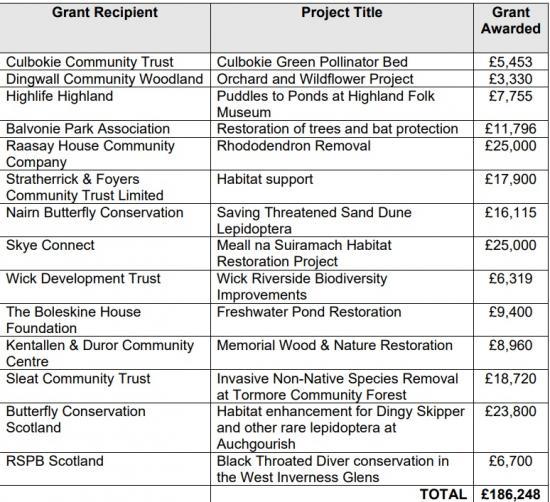Economy & Infrastructure Committee Agrees Funding Proposals For Nature Restoration Fund 2024/25
3rd May 2024

On 2 May 2024 members of the Economy and Infrastructure Committee of Highland Council agreed the funding proposals for the Nature Restoration Fund scheme for 2024/25.
They further agreed that funding decisions in respect of that fund will be delegated to the Executive Chief Officer for Infrastructure, Environment & Economy and the Chair of the Economy and Infrastructure Committee.
Chair of the Council's Environment and Infrastructure Committee, Cllr Ken Gowans said: "The purpose of the Nature Restoration Fund is to support positive actions that can help nature recover.
"It has been inspiring to see so many projects coming forward to apply for funding as it shows that people all over Highland are driving local action against climate change and threats to habitat."
The Nature Restoration Fund (NRF) is a commitment in the current Scottish Government's Programme for Government for multi-year capital funding to support a wide range of projects that will deliver nature restoration, safeguard wildlife, and tackle the causes of biodiversity loss.
The Nature Restoration Fund has been used positively by a number of community organisations to the benefit of biodiversity in Highland, including the creation of a pollinator bed in Culbokie Green, Dingwall Community Woodland's Orchard and Wildflower project, Butterfly Conservation Scotland's work to enhance the habitat for Dingy Skipper and other rare lepidoptera at Auchgourish, the restoration of trees and bat protection by the Balvonie Park Association and Skye Connect's Meall na Suiramach Habitat Restoration Project, to name only a few.
It has also allowed Highland Council to employ a Greenspace Officer whose focus is on delivering nature restoration projects on Council owned land. This has included five tree planting projects which have seen the planting of over 2,700 native trees across the region.
Dr Tom Prescott, Butterfly Conservation Scotland's Head of Conservation, said: "Highland Council's NRF funding has been a game changer for our work to enhance habitat for rare and threatened butterflies and moths in the Highlands.
"This includes improving the fortunes of Small Blue and Dingy Skipper at Logie Quarry with Balnagown Estate, working with Novar estate to benefit Netted Mountain Moth and most recently restoring the dunes at Nairn for Small Blue and a suite of duneland moths, including Portland Moth.
"It has also allowed us to work more closely with these landowners and continue our work at these sites through other projects."
In 2023/24 the Highland Council secured £676k of NRF funding, which represented an increase of £348k from 2022/23.
The many examples of how the funding was used in 2023/24 can be seen under Item 12 at Appendix 1 of the report to today’s committee.
Although no formal announcement has yet been made, it is anticipated that NRF funding will once again be made available to local authorities in 2024/25.
See https://www.highland.gov.uk/meetings/meeting/4964/economy_and_infrastructure_committee
2023/24 Nature Restoration Fund Highlights
and supported as part of the Council’s Environment Team, is building on a previous 5.1 The newly appointed Greenspace Officer has focused on delivering nature restoration projects on Council owned and managed land. The Greenspace Officer, working within
phase of work to start to map parts of the Council estate that could be managed more effectively for biodiversity, to identify sites that could be used by the community for wildlife-friendly food growing (including establishing community orchards and ‘fruit forests’) and to help the Council deliver carbon and cost savings in how it manages its estate. The latter half of 2023/24 saw the start of the implementation of projects on the ground, including:-
1. Five pilot tree/shrub planting projects at Bignold Park and Wellington Avenue Park in Wick;
Torvean Park and Merkinch Nature Reserve in Inverness;
Thurso Roads Depot; and Riverside Park in Nairn have been delivered in the last few months. This has resulted in the planting of over 2,700 native trees and hedgerows to either introduce new/reinstate habitat or strengthen existing habitat.
For 2024/25 multiple additional planting sites have been identified, subject to agreement with the relevant service.
2. Identification and implementation of a suite of low mow/reduced management sites (working closely with colleagues in Amenity Services). Reduced management, or set aside, involves a change in maintenance regimes on select greenspaces to support wildlife, allowing native grasses and wildflowers to establish and thrive in a more natural way than current maintenance regimes allow. This also delivers a carbon and cost saving to the Council.
3. Identification of key areas of the school estate that are suitable for nature-positive enhancement, including orchards, reduced management/set aside areas, food growing and native tree planting. The Greenspace Officer has been in contact with schools to explore options and opportunities with schemes starting to be delivered within the 2024/25 winter planting season. Schools currently identified include Culloden Academy, Balloch Primary, Teanassie Primary, Charleston Academy, Auchtertyre Primary, Cauldeen Primary and Hilton Primary and working with the Flourish project at North Kessock Primary.
4. The development of an ArcGIS Storymap information page (to be accessible from the Council website) to provide publicly accessible information on each project and outline what the Council are doing across our estate to tackle the ecological emergency and reverse biodiversity loss.
5. Spatially mapping all of the Council’s sites that are being managed for biodiversity
to help fulfil the Council’s requirement under NPF4 to design and implement nature networks.
5.2 As per previous years, in 2023/24 the Council has run a Community Grant Scheme for Biodiversity to fund the delivery of smaller-scale (up to £25k) public and third sectors projects that support the management, enhancement, and restoration of biodiversity, and accord with the themes highlighted in paragraph 4.3
